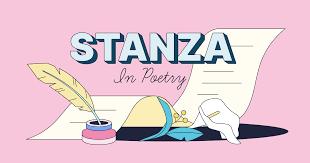STANZA FORMS
Stanza Defined

Stanzas are a series of verses grouped and isolated by a blank space to give the poem an organization. They are similar to the paragraph in a piece of prose. To recognize a stanza, one should check the number of lines.
Types of Stanza
There are several stanza forms accessible to poets composing English poetry. The most used ones are provided below:

- THE COUPLET
The couplet is the name
for two rhyming lines of verse following immediately after each other forming a stanza; it was first introduced in English
poetry by Edmund Waller. The couplet can be generally termed Heroic Couplet
especially, in John Dryden’s Translation
of Virgil (1697) and Pope’s Translation
of Homer’s Iliad
(1715). The famous Couplet by Alexander Pope is a reflection on good values:
Good nature and good sense must
ever join
to err is human, to forgive, divine
Also labeled the triplet, is a three-line stanza, introduced into English poetry by Sir Thomas Wyatt in the 16th century. It was employed by Shelley and is the form used in Byron’s The Prophecy of Dante and Mathew Prior Jinny the Just; here is an excerpt from Jinny the Just:
Releas'd from the noise of the butcher and baker
Who, my old friends be thanked, did seldom
forsake her,
And from the soft duns of my landlord the
Quaker,
From chiding the footmen and watching the
lasses,
From Nell that burn'd milk, and Tom that broke
glasses
(Sad mischiefs thro' which a good housekeeper
passes!)
- THE QUATRAIN
It is a four-line stanza, the first form used in popular English literature. It was perfectly used by the poet Edward Fitzgerald in his translation of Rubaiyat Omar Khayyam. We have two types of quatrain
a- Heroic quatrain: with rhyme patterns (abab) used in Thomas Gray’s, Elegy Written in a Country Churchyard which is a poem written in a series of quatrains. E.g.
Now fades the glimm'ring landscape on the sight, (a)
And all the air a solemn stillness holds, (b)
Save where the beetle wheels his droning flight, (a)
And drowsy tinklings lull the distant folds; (b)
a- Memoriam stanza with rhyme patterns (abba) used in Lord Tennyson’s “In Memoriam” e.g.
|
Behold, we know not anything; (a) |
|
|
|
I can but trust that good shall fall (b) |
|
|
|
At last—far off—at last, to all, (b) |
|
|
|
And every winter change to spring. (a) |
||
- THE QUAINTAIN
A cinquain or quintain is a five-line stanza. Percy Bysshe Shelley is one of the poets who wrote in Quintains his poem To a Skylark e.g.
Hail to thee, blithe Spirit!
Bird thou never wert,
That from Heaven, or near it,
Pourest thy full heart
In profuse strains of unpremeditated art.- THE SESTET AND OCTAVE
The sestet is a six-line stanza and the octave is an eight-line stanza (8 lines). These two forms are frequent with a sonnet distributed into two parts: an octave+ a sestet as did John Keats in his famous sonnet “On First Looking into Chapman’s Homer”
Much have I travell'd in the realms of gold,
And many goodly states and kingdoms seen;
Round many western islands have I been
Which bards in fealty to Apollo hold.
Oft of one wide expanse had I been told
That deep-brow'd Homer ruled as his demesne;
Yet did I never breathe its pure serene
Till I heard Chapman speak out loud and bold:
Then felt I like some watcher of the skies
When a new planet swims into his ken;
Or like stout Cortez when with eagle eyes
He star'd at the Pacific—and all his men
Look'd at each other with a wild surmise—
Silent, upon a peak in Darien.
- THE SEPTET:
But our love it was stronger by far than the love
Of those who were older than we,
Of many far wiser than we,
And neither the angels in heaven above,
Nor the demons down under the sea,
Can ever dissever my soul from the soul
Of the beautiful Annabel Lee
